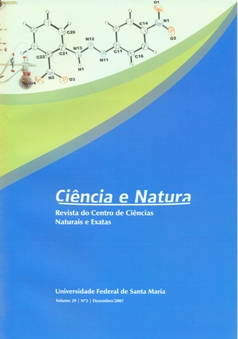Análise da Variabilidade Térmica em Zonas de Bordas Florestais com Interface Urbana no Maciço da Tijuca Rio de Janeiro-RJ
DOI:
https://doi.org/10.5902/2179460X9892Resumo
Esta pesquisa teve por objetivo identificar e avaliar o gradientetérmico gerado pela propagação do efeito de borda na interface floresta –cidade, em duas áreas selecionadas com diferentes graus de adensamentourbano (área do Catrambi - alta densidade, e área do Soberbo- baixa densidade),nas bordas da Floresta da Tijuca - Rio de Janeiro (RJ). Tomou-secomo hipótese inicial que o aumento da pressão urbana na zona de interfacefloresta-cidade acarreta uma modificação na dinâmica do efeito de borda,acelerando sua propagação, especialmente no que se refere às mudanças detemperatura, com rebatimento direto na funcionalidade do sistema. Os levantamentosde campo foram realizados a partir de três transectos de 100metros de extensão em cada área (com 5 parcelas de 100 m2 em cadatransecto). Os resultados desta pesquisa apontaram que a diferença na densidadede urbanização entre as duas áreas pesquisadas influi significativamentesobre a propagação do efeito de borda (com diferenças de até 3,5°Cno transecto borda-centro), porém não de forma direta, já que o faz pormeio do aumento da densidade de trilhas e caminhos internos à zona deborda.Downloads
Downloads
Publicado
Como Citar
Edição
Seção
Licença
Para acessar a DECLARAÇÃO DE ORIGINALIDADE E EXCLUSIVIDADE E CESSÃO DE DIREITOS AUTORAIS clique aqui.
Diretrizes Éticas para Publicação de Revistas
A revista Ciência e Natura está empenhada em garantir a ética na publicação e na qualidade dos artigos.
A conformidade com padrões de comportamento ético é, portanto, esperada de todas as partes envolvidas: Autores, Editores e Revisores.
Em particular,
Autores: Os Autores devem apresentar uma discussão objetiva sobre a importância do trabalho de pesquisa, bem como detalhes e referências suficientes para permitir que outros reproduzam as experiências. Declarações fraudulentas ou intencionalmente incorretas constituem comportamento antiético e são inaceitáveis. Artigos de Revisão também devem ser objetivos, abrangentes e relatos precisos do estado da arte. Os Autores devem assegurar que seu trabalho é uma obra totalmente original, e se o trabalho e / ou palavras de outros têm sido utilizadas, isso tem sido devidamente reconhecido. O plágio em todas as suas formas constitui um comportamento publicitário não ético e é inaceitável. Submeter o mesmo manuscrito a mais de um jornal simultaneamente constitui um comportamento publicitário não ético e é inaceitável. Os Autores não devem submeter artigos que descrevam essencialmente a mesma pesquisa a mais de uma revista. O Autor correspondente deve garantir que haja um consenso total de todos os Co-autores na aprovação da versão final do artigo e sua submissão para publicação.
Editores: Os Editores devem avaliar manuscritos exclusivamente com base no seu mérito acadêmico. Um Editor não deve usar informações não publicadas na própria pesquisa do Editor sem o consentimento expresso por escrito do Autor. Os Editores devem tomar medidas de resposta razoável quando tiverem sido apresentadas queixas éticas relativas a um manuscrito submetido ou publicado.
Revisores: Todos os manuscritos recebidos para revisão devem ser tratados como documentos confidenciais. As informações ou ideias privilegiadas obtidas através da análise por pares devem ser mantidas confidenciais e não utilizadas para vantagens pessoais. As revisões devem ser conduzidas objetivamente e as observações devem ser formuladas claramente com argumentos de apoio, de modo que os Autores possam usá-los para melhorar o artigo. Qualquer Revisor selecionado que se sinta desqualificado para rever a pesquisa relatada em um manuscrito ou sabe que sua rápida revisão será impossível deve notificar o Editor e desculpar-se do processo de revisão. Os Revisores não devem considerar manuscritos nos quais tenham conflitos de interesse resultantes de relacionamentos ou conexões competitivas, colaborativas ou outras conexões com qualquer dos autores, empresas ou instituições conectadas aos documentos.






